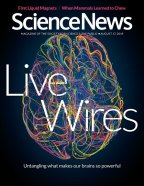Readers contemplate climate change and neural connections
Your comments and questions on the August 17, 2019 issue of Science News
- More than 2 years ago
Not just neurons
Scientists at the Allen Institute for Brain Science in Seattle are probing neurons to understand how those cells let us think and act in ways that other animals can’t, Laura Sanders reported in “How pieces of live human brain are helping scientists map nerve cells” (SN: 8/17/19, p. 22).
“The excellent article on neurons … mentions that the answer to humanity’s difference may not lie in the neurons at all, but in other cells, such as the glial cells,” reader Devin J. Starlanyl wrote. “I have contacted quite a few people doing neuron research over the years,” she wrote. “When I ask them why they are working with neurons, their reply has always been the same. The answers might be with the glial cells, but the money goes to the neuron research.”
Neurons have long been considered the stars of the brain, likely responsible for really important jobs, such as memory, emotions and consciousness itself, Sanders says. “But it’s true that glial cells, which are often described as supporting cast members that help neurons operate, are having a moment.” Scientists are finding more unexpected and complex jobs for these brain cells: Glia have the power to change conversations between neurons by releasing chemical signals, regulating blood flow and even gobbling up neural connections (SN: 8/22/15, p. 18). Though there’s never enough research money to go around, Sanders says, “with so many basic facts about the brain unknown, studying any cells in the human brain, neurons or glial cells, will undoubtedly lead to insights.”
Carbon solutions
Planting roughly 1 billion hectares–worth of trees could trap about two-thirds of the carbon released by human activities since the Industrial Revolution began, Susan Milius reported in “Planting trees could buy more time to fight climate change than thought” (SN: 8/17/19, p. 4).
The story reminded reader Ron Blachman of the IronEx experiments, in which fertilizing the ocean with iron boosted carbon-absorbing algal blooms (SN: 9/30/95, p. 220). When those algae die, they sink to the ocean floor, taking carbon with them. In theory, more blooms could mean more carbon gets stored in the deep ocean. Blachman suggested scientists might also take an approach similar to IronEx.
Concern over climate change is resurrecting geoengineering ideas such as Blachman’s, says Science News earth and climate writer Carolyn Gramling. “But there’s a lot we don’t know about consequences.” Some experiments hint that iron fertilization of the ocean could boost levels of nitrous oxide or methane in the atmosphere. And fertilizing one patch of ocean might not trigger an overall bloom bonanza. What’s more, big blooms in one locale could take additional nutrients away from other areas, she says.
Correction
“Textile archaeologists use ancient tools to weave a tapestry of the past” (SN: 8/31/19, p. 16) incorrectly reported that people started spinning thread around the fourth century B.C. People probably started in the fourth millennium B.C.
